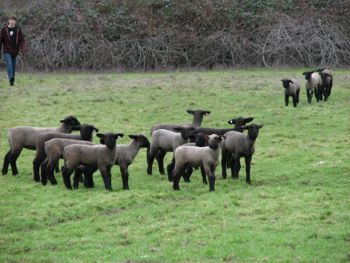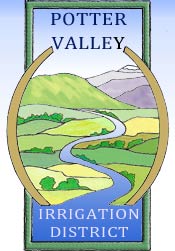Potter Valley Agriculture
Frost Protection, Irrigation and Storage Ponds
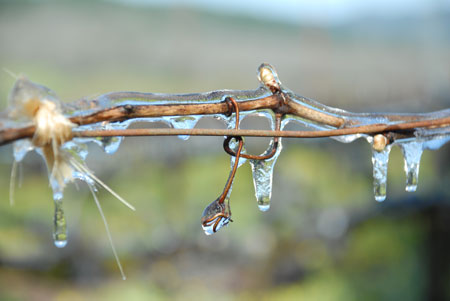 PVID delivers water to our customers as required for spring frost protection and for summer and post harvest irrigation. In the spring it is not unusual to have 1-15 nights of freezing temperatures, at a time in their growth cycle when sensitive crops would suffer severe damage without water for frost protection. The frost protection season is variable. Since 1967 we have had as many as 27 consecutive nights of frost protection between March 15th and May 10th, and as few as one night during the same time period. We have approximately 2,100 acres of crops that require frost protection. Our frost sensitive crops include pears, wine grapes, some nurseries and row crops.
PVID delivers water to our customers as required for spring frost protection and for summer and post harvest irrigation. In the spring it is not unusual to have 1-15 nights of freezing temperatures, at a time in their growth cycle when sensitive crops would suffer severe damage without water for frost protection. The frost protection season is variable. Since 1967 we have had as many as 27 consecutive nights of frost protection between March 15th and May 10th, and as few as one night during the same time period. We have approximately 2,100 acres of crops that require frost protection. Our frost sensitive crops include pears, wine grapes, some nurseries and row crops.
Potter Valley has a unique microclimate in the spring that precluded the use of wind machines alone, or of low volume water misting systems. Wind machines require a naturally occurring warm air inversion layer, or, historically, smudge pots to produce artificial heat, allowing the wind machines to move warmer air and mix it with the cold freezing air near the ground. Potter Valley rarely has an inversion layer close enough to the ground to provide the warmer air required to mix into the cold air at ground level. Potter Valley also normally has relatively long freezing temperature durations and low dew points. The dew point is the temperature at which water molecules in the air coalesce to form water droplets. This is commonly seen as dew, or fog, on cold mornings. Because we have long durations of freezing temperatures and low dew points, water misters do not function. In fact, growers have tried to use them in Potter Valley over the years, only to find that they freeze quickly under low dew point conditions. Mister systems have been removed and been replaced by overhead sprinkler systems which are the most efficient method of frost protection used in Potter Valley.
Overhead sprinklers function in two ways to protect crops from frost damage. First, as the water sprayed from the sprinklers cools it releases heat into the air surrounding the sensitive new plant buds. Second, as time goes on, and the temperature continues to drop, a layer of ice forms around the buds and acts as insulation. As long as water keeps dripping off of the outer coating of ice, the plant tissue will not freeze. Each frost night in Potter Valley the farmers normally use 100 to 150 acre feet of water. Over the last ten years PVID has averaged 1,000 acre feet of water per year sold for frost protection.
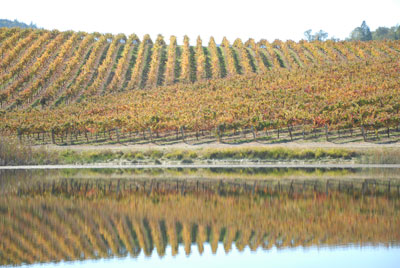 When temperatures near freezing, all frost sensitive crops need to be protected at the same time. However, it is impossible for PVID to deliver water to all the growers that need frost water at the same time. Therefore, PVID has a policy that if growers require frost water they must have a pond that can hold at least five nights worth of the amount of water needed for protecting the number of acres requiring frost protection. During the frost season PVID fills ponds in the days following a frost event so that growers are ready for the next night of frost. PVID's system, with only 50 cfs allowed under our contract with PG&E, is marginally able to refill frost ponds, especially if we have several consecutive nights of frost. This is one reason why PVID's right to use water below the Potter Valley Project is so critically important. The value of frost sensitive crops, that could be lost in a single night of frost without water for protection, is estimated to be over 15 million dollars.
When temperatures near freezing, all frost sensitive crops need to be protected at the same time. However, it is impossible for PVID to deliver water to all the growers that need frost water at the same time. Therefore, PVID has a policy that if growers require frost water they must have a pond that can hold at least five nights worth of the amount of water needed for protecting the number of acres requiring frost protection. During the frost season PVID fills ponds in the days following a frost event so that growers are ready for the next night of frost. PVID's system, with only 50 cfs allowed under our contract with PG&E, is marginally able to refill frost ponds, especially if we have several consecutive nights of frost. This is one reason why PVID's right to use water below the Potter Valley Project is so critically important. The value of frost sensitive crops, that could be lost in a single night of frost without water for protection, is estimated to be over 15 million dollars.
Summer and fall irrigation is very different. All crops and livestock require summer water. There are many different methods used for the application of summer water. Pastures are flood irrigated. Orchards predominately are irrigated with under tree sprinklers. Vineyards use very efficient drip emitters that precisely deliver water to each vine. Some nurseries use micro emitters. The summer and fall irrigation season is normally from mid May until the first rains in November. Irrigation water is delivered on a rotational schedule. Starting in the north of the valley, water is rotated through the district lateral every 10 to 14 days. Some crops require more water than others. For example, a calculation of 5 years of PVID water use showed pastures use, on average, 4.32 acre feet of water per acre per year, pears use 3.48, row crops use 3.57 and vineyards use 2.07 acre feet of water per acre per year. (These numbers include frost water.)
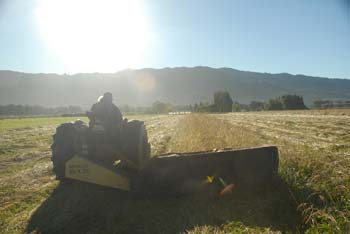
The Agricultural Economy of Potter Valley
The farmers in Potter Valley dry farmed crops and raised cattle before the Potter Valley Project existed. Suddenly, with summer water, the face of Potter Valley changed. Farmers could grow ladino clover and alfalfa for the dairies, orchards were planted where they couldn't have been before, farmers cut hay three or four times instead of once or, on a wet year twice.
The agricultural economy of Potter Valley has grown with the presence of the water diverted through the Potter Valley Project. Today there are no dairies and no one grows clover for seed, red kidney beans or alfalfa. There aren't as many sheep and large fields of melons are a memory. But there are still pear orchards, the best grass hay in the country, beef cattle, native plant nurseries, specialty crops and wine grapes. Today the crops grown in Potter Valley provide $33,252,000 of economic value to the County of Mendocino. Potter Valley farms innovate in Integrated Pest Management and sustainable and organic growing practices.
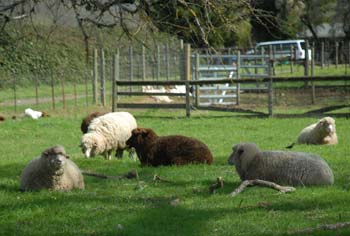
For over 100 years the water diverted from the Eel River has been put to beneficial use first as it produces power at the Potter Valley Powerhouse and again as it passes through several smaller privately owned hydroelectric power plants in Potter Valley. The same water is used again to irrigate crops in Potter Valley and again to supply agricultural and domestic water for the communities of Redwood Valley, Calpella, Ukiah, Talmage and Hopland. The water is stored and used over and over as it travels down the Russian River and into Sonoma and Marin Counties where it is used, yet again, to augment river flows for migrating salmon and steelhead.
